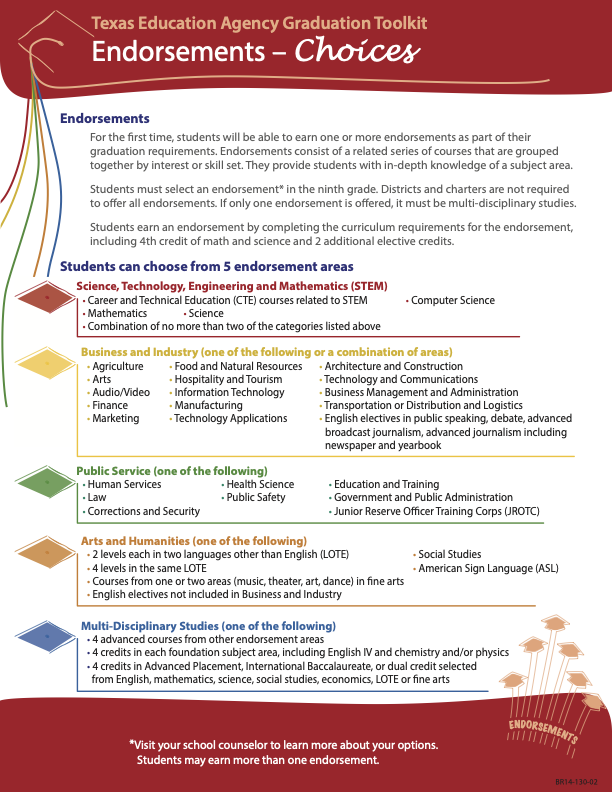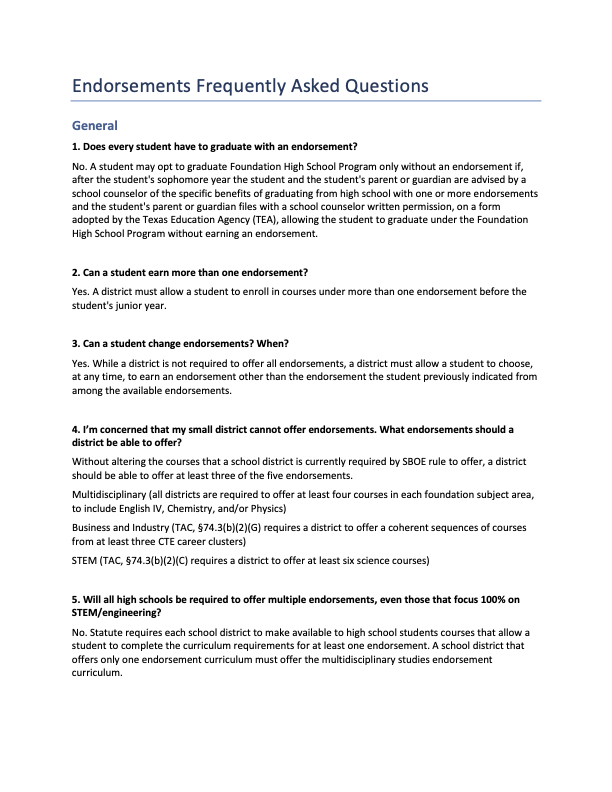
We are proud to share this guest blog post by Maricela Luna, Executive Director of Pathways Home Education, offering advice about endorsements on Texas high school diplomas for students who may be changing schools for high school.
The availability of school choice has provided families with the opportunity to tailor their children’s education to best meet their needs and preferences. These rapidly growing options in San Antonio today allow parents to make informed decisions based on factors such as academic philosophy, curriculum offerings, extracurricular activities, class sizes, and school culture. It’s not uncommon for families to reassess their school choice decisions, especially during transitional periods such as the end of the academic year. As the current school year comes to a close and families look ahead to the next academic year in the fall, they may reflect on their child’s educational experience, consider their evolving needs and priorities, and contemplate whether a different school setting may better align with their goals.
Encountering High School Endorsements
Transitioning between different models of schools, such as from private or charter middle school to public high school, can present both challenges and opportunities for students and parents. It’s completely understandable for parents to feel overwhelmed by school lingo and educational terminology, especially when it comes to navigating high school endorsements, CTE (Career and Technical Education), and other requirements. Endorsements, as a graduation requirement in most public high schools, may be unfamiliar to parents who are transitioning from other educational settings. However, they offer a unique opportunity for students to tailor their high school experience to their interests, strengths, and future goals. Endorsements in high school typically refer to an official recognition or approval of a student’s proficiency or achievement in a particular area of study or extracurricular activity. Some common types of endorsements in high school include academic, extracurricular, specialized, leadership, and CTE.
What Are Endorsements?
In Texas, students and parents are required to choose an endorsement as they enter high school. The Texas Education Agency (TEA) implemented the endorsement system as part of the state’s graduation requirements.
Students must select one of five endorsements:
- STEM (Science, Technology, Engineering, and Mathematics)
- Business and Industry
- Public Services
- Arts and Humanities
- Multidisciplinary Studies
Each endorsement pathway consists of a specific set of courses designed to prepare students for post-secondary education or the workforce in their chosen field. Students are required to complete requirements, to earn a diploma.
Below are two examples of endorsement sequences:


Process for Choosing an Endorsement
Choosing an endorsement is an important decision for Texas high school students. It is essential for students to consider their interests, strengths, and career goals when selecting an endorsement to ensure they make the most of their high school experience and set themselves up for success after graduation. You may be surprised to know that the decision-making process starts in middle school.
Here are some suggestions for how students and parents can approach this decision if you have an eighth grade student and are contemplating transitioning to a public high school.
Consider Interests and Strengths: Encourage students to reflect on their interests, passions, and strengths. What subjects do they enjoy the most? What extracurricular activities or hobbies do they participate in? Identifying areas of interest can help guide the endorsement selection process.
Explore Career Goals: Discuss long-term career aspirations with the student. Certain endorsements may align more closely with specific career paths or industries. Consider how each endorsement option may support the student’s future goals and interests.
Research Public School Options: Explore the public high schools in your area to understand the educational offerings, graduation requirements, extracurricular activities, and support services available. Look into the specific endorsement pathways offered by each school and consider how they align with your child’s interests and future goals.
Research Endorsement Options: Research the endorsement options available at the high school of interest. Common endorsements might include STEM (Science, Technology, Engineering, and Mathematics), Fine Arts, Humanities, Business and Industry, Public Service, Multidisciplinary Studies, or Career and Technical Education (CTE) pathways. Understand the courses, activities, and opportunities associated with each endorsement.
Review Course Offerings: Review the courses and curriculum associated with each endorsement option. Consider the types of classes, projects, and activities students will engage in within each pathway. Choose an endorsement that offers coursework that aligns with the student’s interests and academic goals.
Consult with School Counselors: Schedule meetings with the counselors or admissions staff at potential public high schools to discuss your child’s educational background, academic goals, and any concerns you have about the transition process. They can provide valuable guidance on enrollment procedures, course selection, and how to navigate endorsement requirements. Please consider that certain classes for specific endorsements may be more popular than others and may fill more quickly. By this time of year, school counselors are preparing for the new academic year with teacher master schedules, student numbers per class, and student schedules.
Seek Community Feedback: Reach out to other parents, community members, or alumni who have experience with the public high schools you’re considering. It is still not too late to gather insight and perspectives that can offer valuable firsthand information about the school culture, academic offerings, and overall environment.
Consider Transitional Support: If transitioning to a public high school seems like the right decision for your child, explore options for transitional support to ensure a smooth adjustment. This may include attending orientation sessions, participating in summer bridge programs, or connecting with peer mentors or student support groups.
Ultimately, the decision to transition from a private or charter school to a public high school should prioritize your child’s academic, social, and emotional well-being. By thoroughly researching your options, seeking guidance from school professionals, and considering your child’s individual needs and aspirations, you can make an informed decision that sets them up for success in their high school years and beyond.
Resources for Understanding High School Endorsements
These documents—a brochure and an FAQ—are helpful for understanding endorsements for high school students.

Endorsements Brochure: This brochure from the TEA provides information about endorsements as part of the state’s graduation requirements. It explains the purpose of endorsements, the different endorsement options available to students, and the benefits of selecting an endorsement pathway. The brochure also includes guidance for students and parents on how to choose an endorsement that aligns with their interests and career goals.

Frequently Asked Questions (FAQ) Document: The FAQ document addresses common questions about endorsements and graduation requirements under the Foundation High School Program in Texas. It covers topics such as the number of endorsements required for graduation, the flexibility of endorsement choices, transferability of credits, and additional considerations for students with special circumstances. The document aims to provide clarity and guidance for students, parents, educators, and school administrators navigating the endorsement system.
These resources are valuable tools for parents and students to familiarize themselves with endorsements and make informed decisions about high school course selection and graduation planning. By proactively accessing and utilizing these resources, parents can support their child’s academic journey and ensure they are well-prepared for success in high school and beyond.
Read More About Planning for High School
- “The Haven Is a Co-Learning Center Offered by Pathways Home Education,” San Antonio Charter Moms, December 11, 2023
- “Success Starts Here: Pathways Home Education,” San Antonio Charter Moms, May 25, 2023
- “Team Up for Success: Tools and Resources for Building Stronger Parent Teacher Relationships,” Melissa Rayworth, San Antonio Charter Moms, October 7, 2021
- “Exploring the Paths to Success in High School and Beyond,” Melissa Rayworth, San Antonio Charter Moms, April 8, 2021
